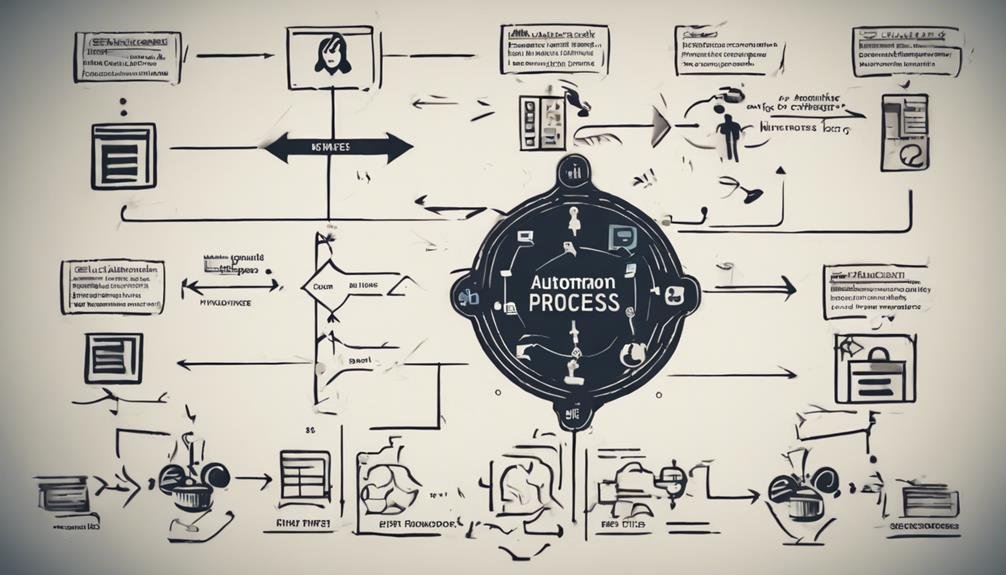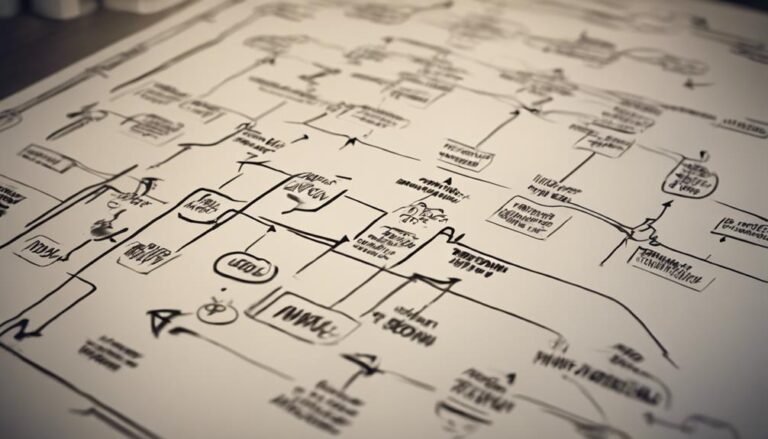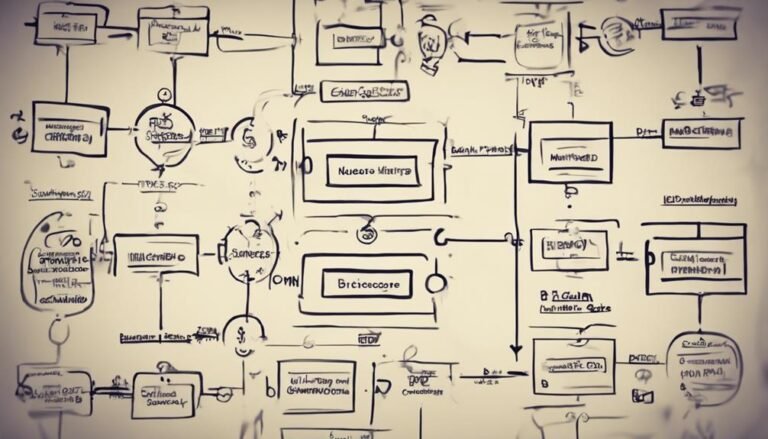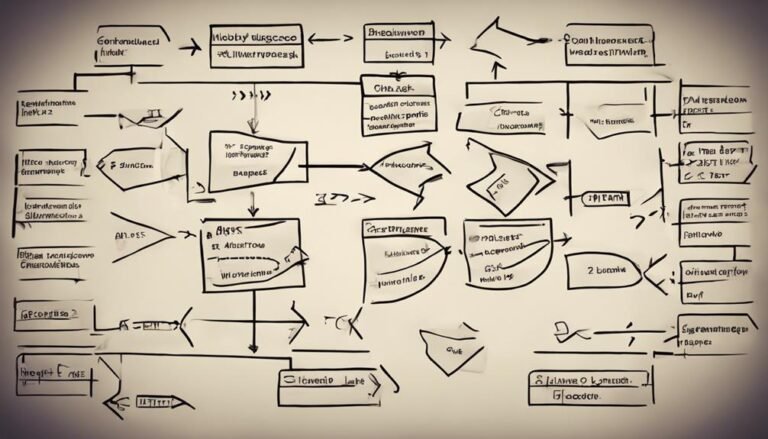Business Process Optimization Strategies
In the dynamic landscape of modern business, the quest for operational excellence is perpetual. Organizations constantly seek strategies to enhance efficiency, cut costs, and boost productivity. Business process optimization lies at the heart of these endeavors, offering a systematic approach towards achieving these goals.
By honing in on key processes, employing advanced analytics, and leveraging technology, companies can navigate towards a path of enhanced performance and competitiveness. However, the journey towards optimized business operations is not without its challenges and nuances.
Key Takeaways
- Identify key processes for understanding workflow and performance.
- Implement automation for productivity, efficiency, and competitive advantage.
- Integrate technology to streamline operations and ensure scalability.
- Enhance communication and monitoring for improved collaboration and decision-making.
Identifying Key Processes
In the realm of business process optimization, the initial step involves identifying the key processes that underpin organizational operations and efficiency. Process identification is crucial in understanding how various activities contribute to the overall workflow. By pinpointing these key processes, organizations can focus their efforts on areas that have the most significant impact on performance.
Performance analysis plays a vital role in evaluating the effectiveness of identified processes. This step involves assessing key metrics, such as cycle time, resource utilization, and quality levels, to determine how well a process is functioning. Through performance analysis, organizations can identify bottlenecks, inefficiencies, or areas for improvement within their processes.
Analyzing Workflow Efficiency
To optimize business processes effectively, it is crucial to employ workflow mapping techniques and bottleneck identification methods.
By analyzing workflow efficiency, organizations can pinpoint areas that require improvement and streamline operations for enhanced productivity.
Understanding the flow of work and identifying bottlenecks are key steps in driving process optimization initiatives.
Workflow Mapping Techniques
Efficient workflow mapping techniques are essential for optimizing business processes and enhancing operational productivity. When analyzing workflow efficiency through process mapping and workflow analysis, consider the following key techniques:
- As-Is Workflow Mapping: Document the current state of the workflow to identify inefficiencies and areas for improvement.
- To-Be Workflow Mapping: Design the ideal future state of the workflow to visualize the optimized process and set goals for improvement.
- Value-Stream Mapping: Identify value-adding and non-value-adding activities within the workflow to streamline processes and reduce waste.
Bottleneck Identification Methods
Analyzing workflow efficiency further involves employing strategic methods to identify and address bottlenecks in the operational processes. Process bottleneck detection and root cause analysis are key in this process. By identifying where processes slow down or where resources are underutilized, organizations can pinpoint performance bottlenecks.
Once the bottlenecks are identified, the focus shifts to optimizing performance by reallocating resources, redistributing workloads, or streamlining processes. This optimization is crucial for enhancing overall operational efficiency and productivity.
Efficient bottleneck identification methods enable businesses to make informed decisions on resource allocation, process improvement, and strategic planning. By addressing these bottlenecks through strategic initiatives, organizations can streamline operations, reduce costs, and improve customer satisfaction.
Implementing Automation Solutions
Implementing automation solutions is a strategic approach to streamline workflow processes, leading to enhanced operational efficiency.
By leveraging technology for optimization, businesses can reduce manual tasks, minimize errors, and improve overall productivity.
Automation offers a competitive edge by allowing organizations to focus on value-adding activities while achieving cost savings and better resource utilization.
Streamlining Workflow With Automation
To enhance operational efficiency and productivity, businesses are increasingly turning to automation solutions for streamlining workflow processes.
Key Points:
- Automation Benefits:
- Automation reduces manual errors and enhances process accuracy.
- It speeds up tasks, leading to quicker turnaround times.
- It allows employees to focus on higher-value activities.
- Workflow Simplification:
- Automation helps in simplifying complex workflows.
- It standardizes processes, ensuring consistency.
- It enables better tracking and monitoring of tasks.
- Cost Efficiency:
- Automation leads to cost savings through reduced labor requirements.
- It helps in optimizing resource allocation.
- It improves overall business competitiveness by driving efficiency.
Implementing automation solutions not only streamlines workflows but also brings about numerous benefits, ultimately contributing to a more agile and competitive business environment.
Enhancing Operational Efficiency
Enhancing operational efficiency through the integration of automation solutions is paramount for modern businesses seeking to optimize processes and drive competitive advantages. By leveraging data analytics, companies can make informed decisions that enhance resource allocation and streamline operations. Implementing automation not only reduces manual errors but also speeds up repetitive tasks, allowing employees to focus on high-value activities. Below is a table illustrating the impact of automation on operational efficiency:
| Benefits of Automation | Description |
|---|---|
| Enhanced Accuracy | Minimizes human errors |
| Improved Speed | Accelerates task completion |
| Optimal Resource Use | Efficient resource allocation |
| Data-Driven Decisions | Informed choices for growth |
This table showcases how automation solutions positively influence business operations, leading to enhanced efficiency and productivity.
Leveraging Technology for Optimization
Leveraging advanced technologies for process optimization through the strategic integration of automation solutions is essential for modern businesses striving to enhance operational efficiency and maintain a competitive edge. Technology integration and process improvement go hand in hand to streamline operations and drive productivity.
Here are three key ways automation solutions can benefit businesses:
- Streamlining Repetitive Tasks: Automation can handle routine, time-consuming tasks, freeing up employees to focus on more strategic initiatives.
- Enhancing Accuracy: Automated systems reduce the margin of error, leading to more precise results and higher data quality.
- Improving Scalability: Automation allows processes to be easily scaled up or down based on business needs, ensuring flexibility and adaptability.
Eliminating Redundancies
In the pursuit of operational efficiency, organizations must address and streamline processes to eliminate redundancies and optimize resource utilization. Redundancy elimination strategies and process improvement tactics are essential for streamlining operations and enhancing efficiency within an organization.
To begin with, conducting a comprehensive review of existing processes is crucial to identify redundancies. This involves mapping out each step of a process to pinpoint any duplications or inefficiencies. Once redundancies are identified, organizations can then implement strategies to streamline operations. This may include standardizing processes, automating routine tasks, or consolidating similar workflows to reduce duplication of efforts.
Moreover, fostering a culture of continuous improvement is key to sustaining efficiency enhancement techniques. Encouraging employees to regularly review and suggest improvements to processes can help in identifying and eliminating redundancies proactively. Additionally, investing in training programs to enhance employee skills and knowledge can further support the optimization of processes by ensuring that tasks are performed efficiently and effectively.
Streamlining Communication Channels
To further optimize operational efficiency, organizations must strategically assess and refine their communication channels for streamlined effectiveness in achieving business objectives. Improving collaboration and reducing delays are key aspects that organizations need to focus on when streamlining communication channels.
Here are three strategies to enhance communication efficiency:
- Implementing a centralized communication platform: By centralizing communication tools such as emails, instant messaging, and project management software, organizations can ensure that information flows seamlessly across teams and departments.
- Establishing clear communication protocols: Setting clear guidelines for communication methods, response times, and escalation procedures can help in reducing misunderstandings and delays in decision-making processes.
- Encouraging regular feedback and updates: By fostering a culture of open communication where feedback is encouraged and regular updates are provided, organizations can ensure that information is shared in a timely manner, leading to improved collaboration and faster decision-making.
Utilizing Data-driven Insights
Data-driven insights play a pivotal role in informing strategic decision-making processes within organizations. They enable businesses to make informed and impactful choices based on factual analysis and trends. By leveraging data visualization techniques, companies can transform complex data sets into visually appealing and easy-to-understand graphics, aiding in the identification of patterns and trends that may not be apparent through raw data alone.
Moreover, predictive analytics implementation empowers organizations to forecast future outcomes based on historical data. This allows for proactive decision-making and risk mitigation strategies. Through the utilization of these tools, companies can optimize their operations, enhance customer experiences, and drive innovation.
Continuous Performance Monitoring
An essential practice in optimizing business processes is the ongoing monitoring of performance metrics to ensure efficiency and effectiveness across all operations. Continuous Performance Monitoring involves real-time monitoring and data analysis to drive improvements and maintain a competitive edge.
Here are three key aspects to consider when implementing continuous performance monitoring:
- Real-Time Monitoring: Utilizing advanced technological tools to track key performance indicators instantaneously allows businesses to react promptly to any deviations from expected outcomes.
- Data Analysis: Conducting in-depth analysis of the collected data enables organizations to identify trends, anomalies, and areas for enhancement, leading to informed decision-making.
- Performance Benchmarking: Establishing benchmarks based on historical data and industry standards helps in measuring current performance levels and setting achievable goals for continuous improvement.
Employee Training and Development
Implementing a structured employee training and development program is crucial for enhancing workforce competencies and driving organizational growth. Skills development plays a pivotal role in ensuring that employees have the necessary tools to perform their roles effectively. Performance reviews are integral in identifying areas where employees may need further training or development opportunities. By investing in employee growth, organizations can foster a culture of continuous learning and improvement, leading to higher productivity and employee satisfaction.
| Benefits of Employee Training and Development |
|---|
| 1. Enhanced Employee Performance |
| 2. Increased Employee Engagement |
| 3. Improved Employee Retention |
Training programs tailored to individual employee needs can address specific skill gaps and empower employees to reach their full potential. Furthermore, linking training initiatives to performance reviews allows for a more targeted approach to skill development. Organizations that prioritize employee training and development are better positioned to adapt to changing market demands and stay ahead of the competition.
Feedback Mechanisms and Adaptation
Effective feedback mechanisms are essential for organizations to adapt and thrive in dynamic business environments. Implementing agile feedback processes can lead to continuous improvement by providing valuable insights into areas that require enhancement.
To optimize feedback mechanisms and ensure successful adaptation, organizations should consider the following strategies:
- Real-time Feedback Loops: Establishing real-time feedback loops allows for prompt identification of issues and enables quick adjustments to be made, fostering agility within the organization.
- 360-Degree Feedback Systems: Implementing 360-degree feedback systems that involve input from peers, subordinates, and supervisors can provide a comprehensive view of an individual's performance, facilitating targeted development and improvement.
- Data-Driven Feedback Analysis: Utilizing data analytics to analyze feedback trends and patterns can offer valuable insights into overarching organizational strengths and weaknesses, guiding strategic decision-making for continuous enhancement.
Conclusion
In conclusion, optimizing business processes is akin to fine-tuning a well-oiled machine, ensuring its seamless operation and maximum efficiency. By identifying key processes, analyzing workflows, implementing automation, eliminating redundancies, and streamlining communication, organizations can achieve unparalleled success.
Continuous monitoring, employee development, and feedback mechanisms are essential for sustained improvement. Embracing these strategies will propel businesses towards greater productivity and profitability, like a ship sailing smoothly towards its destination.







